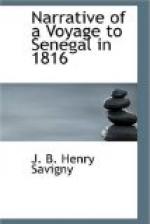This is not the only service which the blacks, who inhabit Senegambia, derive from the Adansonia or Baobab. They convert its leaves, when dried, into a powder which they call Lalo, and use it as seasoning to almost all their food. They employ the roots as a purgative; they drink the warm infusion of its gummy bark, as a remedy for disorders in the breast; they lessen the inflamation of the cutaneous eruptions, to which they are subject by applying to the diseased parts cataplasms made of the parenchyma of the trunk: they make an astringent beverage of the pulp of its fruit; they regale themselves with its almonds, they smoke the calyx of its flowers instead of tobacco; and often by dividing into two parts the globulous capsules, and leaving the long woody stalk fixed to one of the halves, which become dry and hard, they make a large spoon or ladle.
It has been found that the substance, called very improperly, terra sigillata of lemnos, is nothing more than the powder made of the pulp of the fruit of the Baobab. The Mandingians and the Moors carry this fruit as an article of commerce into various parts of Africa, particularly Egypt; hence, it finds its way to the Levant. There it is that this pulp is reduced to powder, and reaches us by the way of trade. Its nature was long mistaken: Prosper Alpinus was the first who discovered that it was a vegetable substance.
After the Isle of Sor, towards the South is that of Babague, separated from the former and that of Safal, by two small arms of the river; this island, in an agricultural point of view, already affords a happy result to the colonists, who have renounced the inhuman traffic in slaves, to become peaceable planters. Many have already made plantations of cotton, which they call lougans. Mr. Artique, a merchant, has hitherto been the most successful. His little plantation brought him in 2400 fr. in 1814, which has excited in many inhabitants of St. Louis a desire to cultivate pieces of land there. After his example, we now see every where beginnings of plantations, which already promise valuable crops to those who have undertaken the cultivation of these colonial productions. The soil of Babague is more elevated than that of the surrounding islands. At its southern extremity, which is precisely opposite the new bar of the river, there is a very great number of huts of the blacks, a military post with an observatory, and two or three country houses.




